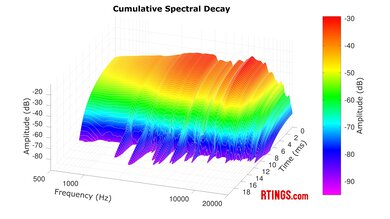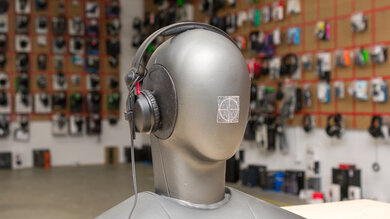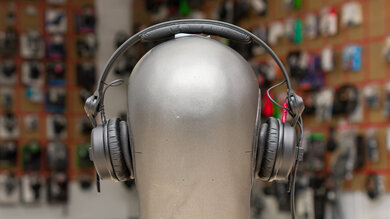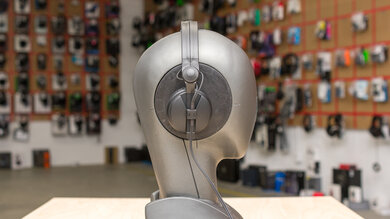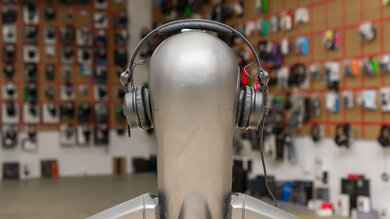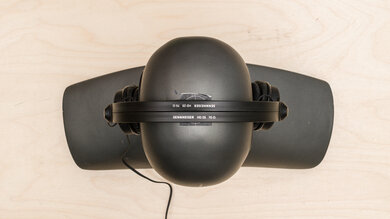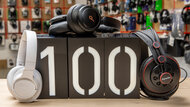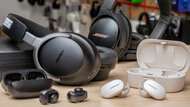The Sennheiser HD 25 are no-fuss, lightweight, on-ear headphones. As wired-only headphones, their comfortable design with a neat headband that splits for added stability aims at DJs or anybody who wants to be the life of the party. Their long cable works for reaching around equipment while staying connected. You can flip your left ear cup back to help you mix and sync tracks without removing the headphones. Besides tweaks with useability in mind, these don't add much in the way of technological advances, but they're also an industry standard for DJs.
Our Verdict
The Sennheiser HD 25 are passable for sports and fitness. Owing mainly to their comfortable, splitting headband that offers good stability, particularly as on-ears go, you can lift weights with these headphones. Their flat sound signature offers a good amount of boom on kick drums, even if it rolls off lower bass frequencies, and the rest of the range plays back clearly to motivate your workout. However, they're wired-only, so you're limited by device connectivity, and the cable can snag on equipment. Plus, they lack an IP rating, meaning they need to avoid dust and rain.
-
Comfortable design.
-
Split headband for better stability.
-
No controls or microphone.
-
Not very portable and wired-only.
The Sennheiser HD 25 are inadequate for travel. These on-ear headphones lack active noise cancelling, so they only muffle high-frequency environmental noise a bit, leaving rumbles, din, and chatter virtually unaffected. This absence of noise cancelling means your environment will compete with your ability to hear your audio via the flat sound signature, which rolls off low frequencies and adds extra boom to bass, with a clear mid-range and slightly uneven top-end. While they're comfortable and lightweight headphones, they're wired-only and don't fold down smaller.
-
Comfortable design.
-
Poor noise isolation.
-
No controls or microphone.
-
Not very portable and wired-only.
The Sennheiser HD 25 are bad for office work. While they're closed-backs, the passive-only isolation doesn't effectively block out noises like coworkers or HVAC systems. The wired-only cans' lack of a mic also means you'll need a separate one for online meetings. Still, their lightweight design is comfortable, and their flat sound signature ensures voices and lead instruments sound pretty true-to-life, so it's decent for music or podcasts.
-
Comfortable design.
-
Poor noise isolation.
-
No controls or microphone.
The Sennheiser HD25 can't connect wirelessly because they're wired-only passive headphones.
The Sennheiser HD 25 are middling for wired gaming. They're limited by the absence of a microphone, so you'll need an outboard mic if you play with others. They also require some care to ensure a consistent sound between wears. The closed-back design doesn't yield an open sound, and they don't meaningfully interact with your ears' pinna for an immersive feel. Still, for fans of comfortable, lightweight headphones for solo gaming and a frequency response that renders dialogue clearly, they might work for you.
-
Comfortable design.
-
No controls or microphone.
-
No additional surround sound or EQ.
The Sennheiser HD 25 have satisfactory audio reproduction accuracy. Their peaks and dips performance provides a smooth flat sound signature. While the low-bass frequencies roll off, the high-bass offers some extra boominess to an otherwise clear mid-range and mostly bright treble. There's a touch of de-emphasis in the low-treble to warm up vocals, while a blast of high-treble adds airiness to the tuning. The group delay is decent, and the stereo mismatch is very good, with tight tolerances. However, the closed-backed on-ears don't interact with your ears' pinna, so audio isn't very immersive.
The Sennheiser HD25 have poor noise isolation performance. As passive on-ear headphones without active noise cancelling, they only muffle high frequencies while leaving low and mid-range noises unaltered. As a result, noises like the rumbles of big rigs on the street still reach your ears, while sounds like old squeaky brakes are slightly quieter, though audible.
The Sennheiser HD25 don't have a microphone.
The Sennheiser HD25 have disappointing frequency response consistency. Generally, on-ears can be slightly finicky compared to over-ears because they don't rest the ear pads around your ear, which is a smoother surface on virtually everyone, rather than the contours of an ear. If your head is large, the bass tends to sound quieter with these cans. While the consistency is a bit better if your head is small, glasses can alter the sound, too, but not very dramatically.
- 6.1 Sports And Fitness
- 5.9 Travel
- 4.2 Office Work
- 3.8 Wireless Gaming (In Development)
- 5.8 Wired Gaming (In Development)
Performance Usages
- 7.3 Audio Reproduction Accuracy
- 4.7 Noise Isolation
- 0 Microphone (In Development)
- 5.4 Frequency Response Consistency
Changelog
-
Updated Jul 29, 2025:
We've updated the Sound Profile box with a link to a downloadable folder of EQ settings that will help you match these headphones' frequency response to different target curves available in our Graph Tool.
-
Updated Jun 17, 2025:
The Portability section was updated to mention that you can detach the headband from the headphones.
-
Updated Apr 25, 2025:
This review has been updated to Test Bench 2.0, which adds the following tests: Stereo Mismatch, Group Delay, Cumulative Spectral Decay, PRTF, Harmonic Distortion, and Electrical Aspects. We've added new performance usages and updated the text throughout the Sound tests and side-by-sides.
- Updated Apr 25, 2025: We've converted this review to Test Bench 2.0, which updates our sound tests and adds performance usages. You can read more about this in our changelog.
-
Updated Oct 30, 2024:
The following test groups have been updated after Test Bench 1.8: Sound Profile, Raw Frequency Response, Bass Profile: Target Compliance, Mid-Range Profile: Target Compliance, Treble Profile: Target Compliance, and Peaks/Dips. Associated text changes have been made to match results from Test Bench 1.7 to Noise Isolation - Full Range and Noise Isolation - Common Scenarios. Text changes have also been made throughout the review to match these results.
Check Price
Differences Between Sizes And Variants
Our unit is 'Black,' the most common color variant of the Sennheiser HD 25. Otherwise, they come in 'Blue' and a limited edition, 'White' color. Besides color palettes, they're all the same model. If you find another variant, please let us know in the comments.
Compared To Other Headphones
The Sennheiser HD 25 are plastic on-ear headphones with analog connectivity. Each model in the HD 25 line is quite similar, with minor differences in accessories and creature comforts. In the tier below are the more spartan Sennheiser HD 25 Light with a cumbersome Y-cable, and above are the Sennheiser HD 25 Plus, which use a different connector to the ear cups and include a carry pouch, spare earpads, and a coiled cable. Sennheiser also produces a Bluetooth-capable entry, the Sennheiser HD 250BT, or you can consider the Pioneer DJ HDJ-CUE1BT on-ears for wireless or wired versatility. While you can use most analog headphones for DJ sets, this line has some unique features, like a splittable headband, that set them apart from other popular picks like the Audio-Technica ATH-M50x, which fit over-ears instead but have a broadly similar bass bump.
For more analog headphones, check out our picks for the best wired headphones. If you're setting the scene for the party, we've narrowed down the best DJ headphones. Searching for smaller cans? Try the best on-ear headphones.
Both the Sennheiser HD 25 and the Sony MDR-7506 have utilitarian designs prioritizing repairability. You can replace almost every part of these headphones. However, besides the metal hinge that flips the Sennheiser's left ear cup forward or backward, they're plasticky headphones but lightweight. Their long cable is straight and detachable, and these headphones fit on your ears. The Sony are plastic, but they have metal integrated throughout the housing. While they're over-ears, they have shallow ear cups. Their long coil cable is surprisingly hefty but not detachable, even though you can unscrew and replace the drivers. They're designed for monitoring sound production, while the Sennheiser are meant for DJing and casual listening.
The AIAIAI TMA-2 DJ and the Sennheiser HD 25 headphones are designed for DJs or fans of on-ear designs and swappable cables. The AIAIAI sound more bass-heavy and warm with very de-emphasized mids and treble. Their design is modular, and you can swap out and replace nearly every component of the AIAIAI with other parts, but as is, they're less comfortable, and you can't pivot the ear cups at all. The Sennheiser cans offer a bump in the high-bass with a clearer mid-range and brighter treble, which is more versatile, but it can depend on your tastes. The unique splitting headband allows them to fit with better stability and comfort. The Sennheiser are the better pick for most DJs. Still, if you're a bass head, the AIAIAI are the better choice.
The Sennheiser HD 25 and the Sennheiser HD 280 Pro 2016 are both aimed at enthusiasts. As a set of on-ear headphones, the HD 25 fit and feel quite different, weighing quite a bit less, and have some added benefits like the left ear cup, which you can flip forward or backward. They have a detachable cable and unimpressive noise isolation, but a unique splitting headband adds security to their fit on your head. Typically, they're used for DJing. The over-ear-fitting HD 280 Pro 2016 are also plasticky in build, notably chunkier in size, and clamp harder. You can collapse them down, which is handy. They're designed for studio use with a different tuning.
The Audio-Technica ATH-M50x and the Sennheiser HD 25 are both popular wired headphones for enthusiasts and DJs alike. One distinction is that the Audio-Technica are over-ear headphones and weigh much more than the lightweight Sennheiser. They can fold down smaller with a travel bag. You get two extra detachable audio cables, and both use different but proprietary cable connectors. In contrast, the Sennheiser fit on-ears. They feel comfortable and don't clamp as hard as the Audio-Technica. The headband can split, which is unique and helps to stabilize the fit.
The Pioneer DJ HDJ-CUE1BT and the Sennheiser HD 25 are on-ear headphones meant for casual and DJ usage. You can use the Pioneer DJ over Bluetooth or via analog, which adds versatility. Their build is plastic with hinges to collapse them down smaller. Because they house batteries, they weigh more, although they aren't heavy. The Sennheiser are passive-only headphones, which are lighter but don't collapse down smaller. While the Pioneer DJ headphones have rotating ear cups, the Sennheiser's left ear cup can pivot forward or backward instead. They use a unique split headband design to help with overall stability, but neither pair will stay completely put if you headbang.
The Sennheiser HD 25 and the V-MODA Crossfade 3 have slightly different goals. The Sennheiser cans are wired-only and fit on-ear. They're simple and lightweight, and you can replace parts, but they're mainly plastic. Compared to the V-MODA, they're brighter. The V-MODA headphones are over-ears, and you can listen to them wirelessly or wired. They have an EQ, which the Sennheiser don't have, but it only works when you're listening over Bluetooth. Their build quality is more durable, and they fold up, but you can't articulate the ear cups to listen with one ear out like on the Sennheiser. The V-MODA are better for on-the-go use, but the Sennheiser are more suitable for monitoring.
Test Results
The Sennheiser HD 25 are tuned with a loosely flat sound signature that somewhat exaggerates high-bass and low-mids with a blast of treble. You can use them for casual listening, and they work well for monitoring dance music, electro, vocal-centric, and other music genres. However, they roll off low-bass rumbles, so deep bass can sound relatively weak with a blast of high-treble emphasis.
The tuning makes sense for DJs, considering that hearing bass and rhythm are key to synchronizing tracks, as are vocals. With the peak halfway through the mid-treble, you won't miss out on any high-pitched subtleties that can inform tracking decisions, but it can sound relatively piercing.
If you're interested in tinkering with their sound, you can download a folder of EQ parameters and use it to tweak the headphones to match the target curves in our Graph Tool more closely.
These headphones have disappointing frequency response consistency. In our testing, people with larger heads tend to experience more inconsistent results in the bass range. The good news for people who wear glasses and have smaller heads is that the consistency isn't too bad.
You'll want to pay attention when you put them on so that the bass and treble regions don't vary between wears. In this regard, the ear cup, which you can pivot forward or backward to free your ear, can allow you to hear the room or someone who needs to chat in the middle of your DJ set without fully removing the headphones. This convenient feature can mitigate some instances where you'd have to remove the headphones and possibly hear an inconsistent frequency response between wears.
The bass target compliance of the Sennheiser HD 25 is okay. It tilts to emphasize the high-bass region yielding a boomy low-end but without a full depth and body. Particularly, the attack of bass instruments, like kick drums and plucked bass strings, gain a bit of added boominess. These don't sound overly rumbly with sub-bass parts like deep bass synth lines, though. For following a song's beat, the high-bass emphasis is useful.
These have excellent mid-range target compliance. A bump in the low-mids that continues from the bass can make busy songs with a lot of bass and mid-range parts sound slightly bloated, but it also thickens bass harmonics, which you may prefer on tracks like She's Lost Control by Joy Division. Throughout the rest of the mids, the sound is quite balanced, meaning that apart from the effects of bass exaggeration, which can slightly overwhelm voices, guitars, and synth pads, it sounds clear.
The treble target compliance is very good. For about two-thirds of the low-treble region, the frequency response follows a flat tuning and sounds like the highest notes of a guitar come across evenly. However, the dip through the low-treble and the mid-treble dulls the articulation and detail of vocals, for instance. The rest of the mid-treble has a prominent peak that can cause early fatigue with its piercing exaggeration of harmonics. However, that can also lend airiness to the top end of your audio, which you may enjoy.
The peaks and dips performance is good, so the headphones match their flat sound signature well for the most part. There are small dips and bumps, but they're relatively minor through the bass and mids. A peak in the low-treble can add a bit of a harsh edginess to vocals. The dip in the low-treble warms up sibilant sounds like S and T, which can sound a bit dull. Meanwhile, a significant peak in the upper-treble lends a piercing exaggeration to other high-pitched sibilants and instrument harmonics, which can prematurely cause your ears fatigue, if you have sensitive ears.
The headphones have very good stereo mismatch performance overall. The L/R drivers are well-matched in weighted amplitude and frequency response. Despite the mismatches in the low-bass and high-treble, these are within good tolerances for a stable stereo image. The weighted phase response exhibits mismatch in the high-treble. However, there isn't much audible musical content in those frequencies, and depending on your hearing's sensitivity to those frequencies, you may not notice it with real-world use. These results are true for our unit, but your pair may differ.
The Sennheiser HD 25's weighted group delay is decent. The bass sounds tight for the most part and the treble sounds transparent. Since these headphones considerably roll-off low-bass in the frequency response, the wobbles in the low-bass group delay isn't significant.
These headphones have terrible pinna-related-transfer-function (PRTF). Most closed-back headphones, by design, have this trait. This lack of interaction with your pinna suggests these do a poor job of mimicking an angled reference speaker.
The Sennheiser HD 25 have very good harmonic distortion. They can reproduce audio cleanly at both 94 and 104 dB/SPL.
These are sensitive headphones that don't need an amp to drive them. They're capable of getting loud, and if connected to a low-noise source, they don't add any noise to your audio. However, due to their sensitivity, they will noticeably amplify any noise in the signal chain if it's already present.
These are the settings used to test these headphones. Our results are only valid when used in this configuration.
The Sennheiser HD 25 headphones are lightweight on-ear headphones with closed backs. The housing and headband are plasticky with exposed, detachable cabling that runs through the right ear cup and along the headband to the left ear cup. They have faux-leather padding along the headband and ear pads—which you can replace. Otherwise, these are minimalist in design. One of their most unique features is the headband, which can split for greater fit adjustments. One of the few pops of color is the red cable to differentiate the right ear cup at a glance. You can flip the left ear cup forward or backward. Our unit is 'Black,' and other colors include 'Blue,' and the limited edition 'White.'
The Sennheiser HD 25 provide good comfort. They're very lightweight compared to other headphones popular with DJs and enthusiasts, and they don't clamp particularly hard, either. For on-ear headphones, they also feel comfortable for long stretches (even if you wear glasses), and despite the visually sparse padding along the headband, they don't add much pressure to the top of your head. You can also split the headband to distribute their weight better. Splitting the headband allows the headphones to stay in place better if you flip the ear cup and accommodate various head sizes. However, if you do wear glasses, flipping the ear cup forward can bump into your glasses. The downside of the headphones is that they warm up quickly, and on-ear headphones, by design, can only feel so comfortable because they apply pressure to your ears.
The Sennheiser HD 25 are middling headphones for portability. They're not particularly large, but they don't collapse down to a smaller footprint, and the ear cups can't rotate flat either. However, their narrow, straight cable and lightweight frame aren't bulky, but they definitely take up space in a bag. Because they don't get more compact, their portability is on par with collapsible over-ears like the Audio-Technica ATH-M50x. That said, if you're really trying to save space, you can fully remove the headband from the ear cups, but if you do that, you might want to get a third-party case or pouch to keep the loose parts together.
These headphones have alright build quality. While the lightweight frame and replaceable parts are positive build choices for the very practical design, they're also very plasticky, besides the metal hinge to pivot the left ear cup. The exposed cabling is useful for replacing the cable if the day comes that it breaks, but it also makes it more vulnerable to damage than if it were sealed into the housing. Our unit arrived out of the box with some slightly loose padding on the headband where it's glued to the headband's plastic. For slightly better build quality in a set of on-ears, the AIAIAI TMA-2 DJ feel more solid and are easier to repair and replace parts. However, you might miss the padded headband on the Sennheiser cans.
These headphones have good stability. Unlike most headphones, the headband splits so you can dial in not only their weight distribution but also create essentially a second point of contact for the headband to grip on your head. This accommodates different hairstyles and head shapes. You can keep them on with small movements and bobs. They can come loose and fall off if you get into your music and headbang. In all, that's normal for on-ear headphones.
The Sennheiser HD 25 have poor noise isolation. On-ear designs generally struggle with passive isolation because they essentially make do with clamping force and muffling materials to seal in your ears, unlike in-ear headphones that fully seal your canal and over-ears that seal around the whole ear. These headphones reduce the loudness of high-pitched sounds, like clinking glasses and some ambient chatter in the mids. As with most passive headphones, they don't suppress bassy sounds whatsoever.
For instance, if you're a DJ, you'll still hear the thump and rumble of what you're playing in the room's speakers. While not the healthiest solution for your hearing, the headphones can get loud to combat poor isolation.
In common scenarios, their noise isolation is poor. Bright sounds like shrieking bus brakes and clatter in the office kitchen are muffled to a degree. However, lower-pitched sounds, like the low ambient din of an airplane cabin, remain untouched by the headphones' passive isolation.
The leakage performance is acceptable overall. A rather large section of high-mids and treble escapes, so folks nearby can hear the treble content of your music, including bright lead instruments, vocals, and cymbals if you're at the office. The sound is thin and bright without significant bass content.
How well others can hear your audio depends on your environment and how loud you set the volume. If you're a DJ, it won't matter because the room will be far louder than anything leaking from your headphones.
The headphones have incredible wired connectivity. You get a single 1/8" TRS cable. It fits into the headband, connects to the ear cups, and hangs down along the right side of the headphones. You can replace the cable if it ever breaks because it's detachable. However, you may have to hunt down the same cable from Sennheiser because it's an uncommon connection. Also in the box is a 1/4" male to 1/8" female adapter.
You can connect the headphones to your PC. The generous cable length won’t hamper your ability to plug into a PC tower on the floor, either. Given that these headphones have a 70-ohm impedance, you can drive them without an amp.
These headphones can connect to your PlayStation's controller via an analog connection but only support audio playback. If you want to talk with friends, you'll need a separate microphone or a gaming headset.
Plugging in the cable to your Xbox controller for audio-only works fine with these headphones. However, you'll need a separate microphone if you want to speak with your friends while gaming.
Comments
Sennheiser HD 25: Main Discussion
Let us know why you want us to review the product here, or encourage others to vote for this product.
Update: We’ve updated the Sound Profile box with a link to a downloadable folder of EQ settings that will help you match these headphones’ frequency response to different target curves available in our Graph Tool.


